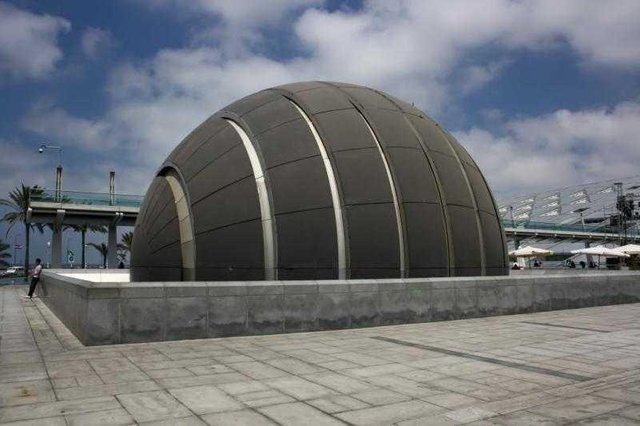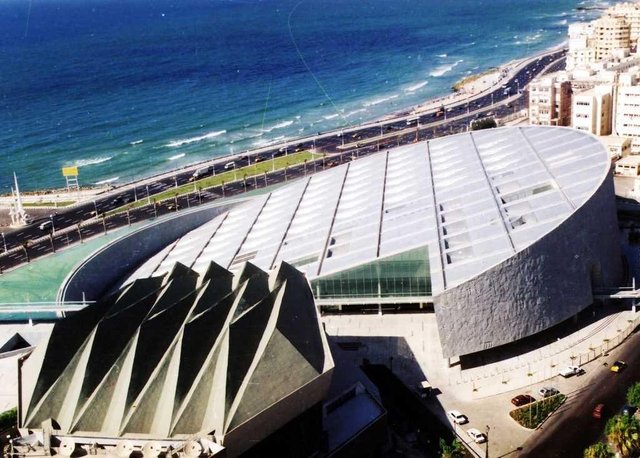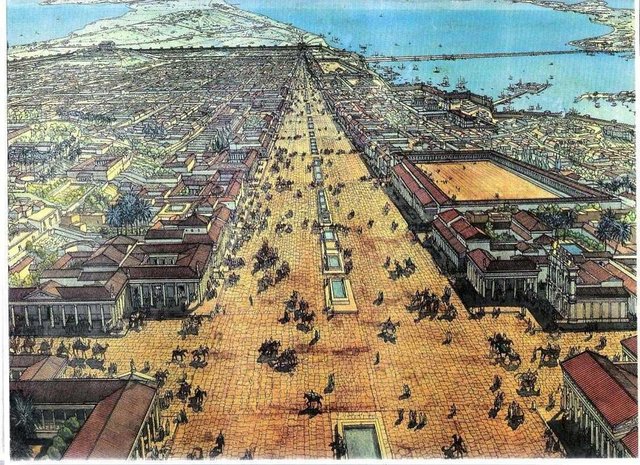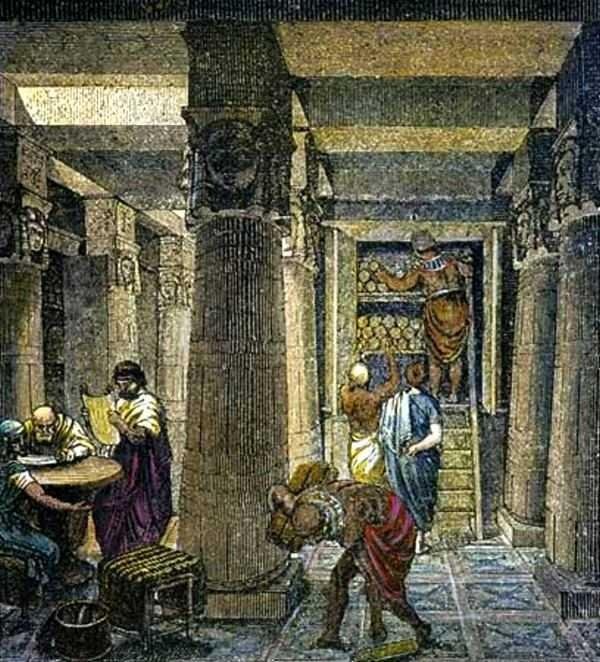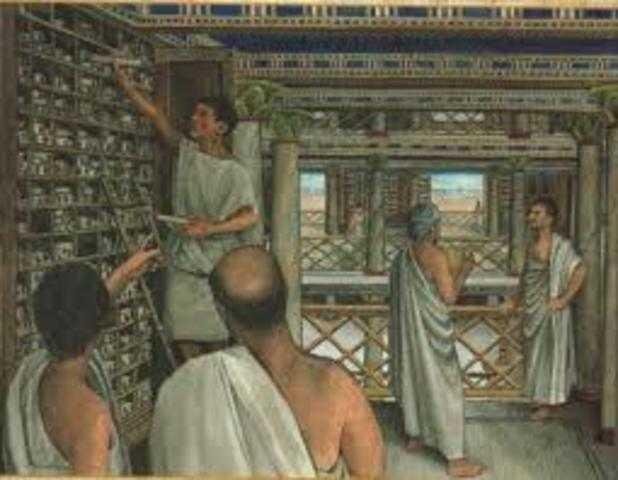Egyptian Studies, Library of Alexandria
The modern Alexandrian Library, named after the beautiful woman Alexandrin (remember, the song in "Pesnyary") is a research institution entitled to be the architectural and cultural heritage of Egypt's new history.
The idea of awakening the world's most famous ancient library was first proposed in 1972 by Mostafa El Abbadi, a professor at the University of Alexandria and enthusiastically supported by the international community. In 1988, UNESCO announced an architectural tender for the creation of a new library, which was won by Norwegian company Snøhetta. At the Aswan conference in 1990, funding for the construction of a new library in Alexandria was supported by many countries around the world.
The site for the construction of a new library was chosen next to Alexandria University, not far from the ancient temple site of culture and science.
The construction of a $ 200 million facility was completed in 2001, and the library design received a worldwide assessment. In fact, the library building is a large cylinder, protruding from the earth 40 meters from the Mediterranean coast. The roof of aluminum and glass panels in the form of discs symbolize the sun rising over the sea. The outer walls of the gray Aswan granite structure consist of about 6,400 panels depicting symbols and letters of all known alphabets.
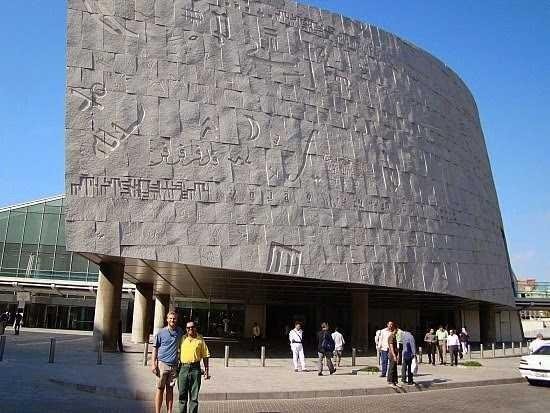
Officially the complex opened on October 16, 2002. The library is designed to accommodate eight million volumes on seven cascading levels. This collection lies in such a way that the oldest material occupies the lowest level, forming a metaphorical basis for subsequent works.
Historical deviation
After Alexander's death from Macedonia in Babylon (323 BC), the Egyptian ruler became his companion, Ptolemy I. During the reign of Ptolemies, Alexandria replaced the ancient city of Memphis, the capital of Egypt. This marks the beginning of the glory of the northern capital of Egypt.
However, no dynasty can exist without the support of its people, and Ptolemies understands this perfectly. Thus, Ptolemies seeks to legitimize their dominance in various ways, including the adoption of the Pharaonic title, the creation of the Serapis-Roman-Roman cult and the protection of the development of science and education. It is this patronage that led to the creation of the great Library of Alexandria.
The basic library and research and education center Muzeon (Mouseion) is undeniably related to the name of Athena politician Demetrius Phaleron. After the fall of the government in Athens Demetrius, who took refuge in Egypt, Ptolemy Soler (297 BC E.), he became one of the main advisers to Pharaoh. Ptolemy immediately exploited his extensive knowledge of Demetrius and in 295 BC ordered him to create libraries and scientific centers.
Second century BC "Letter of Aristeus" indicates that the institution is understood as a universal library:
"... ... Demetrius had before a big budget to raise, if possible, all the books in the world ... the best of his abilities, he fulfilled the duties of Pharaoh ..."
Hunting Books
One of the methods for filling libraries, which are extensively used during the Ptolemaic period, is to search every ship that arrives at the port of Alexandria. Sort of customs control. If the book is found, it is sent to the library for a decision - to return or seize it, replace it with a copy made in place (with proper compensation to the owner). The books received in this way are set "from the ship".
Another story (illuminated by Galen in the writings of Hippocrates) shows how Ptolemy III managed to obtain the original text of the great poets Aeschylus, Sophocles, and Euripides. Precious manuscripts are kept in the archives of Athena, and they are not allowed to give, to anyone. However, Pharaoh persuaded the governors of Athens to permit the copying of invaluable texts. A large number of silver talents were paid in Athens as a guarantee of their secure compensation, and Ptolemy, having received the original documents, sent copies of it, voluntarily losing the collateral.
This original collection method comes with book purchases, most often from Athens and Rhodes, which was the largest book market of the time. Sometimes library collectors buy different versions of the same work, such as Homer texts derived from "Chios", "Sinop" and "Massilia".
Books in all languages of the world
From other languages, besides Greek, the largest part of Egypt. Ptolemy I, as ancient sources, urged Egyptian priests to collect records of ancient traditions and inheritance, enabling them to study experts from around the world, whom he was invited to live in Egypt.
In addition to the main body of Greek literature and Egyptian records, there is evidence that other people's works are written in the library. In the early third century BC. e. A Khalid priest named Beroun wrote (in Greek) the story of Babylon. His book was quickly recognized in Egypt and probably used by the Greek thinker Maneto.
According to Pliny the Elder, Hermipp in Alexandria wrote a detailed book on Zoroastrianism.
The Buddhist scriptures also became available, as a result of the exchange between the Asoka embassy and Ptolemy II from Philadelphia.
The Pentateuch translation from Hebrew to Greek was a practical necessity for the great Jewish community of Alexandria at the end of the 3rd century BC. The translation is done in parts (III and II of the century BC), which becomes possible due to the availability of research material from the Library of Alexandria. "Pentateuch" has survived as the most valuable work in translation history and is still indispensable to all biblical studies.
Library Extension
Merging libraries with Mouseion leads to the establishment of a large research center. Located in a royal palace next to the harbor, the scientific center is under the tight control of the pharaohs. This situation contributes to the rapid growth of library collections. During the first half century, in the year 295 BC, the Royal Library collection no longer fit the space allocated for the storage of collected books. It was decided to create a room that could contain excess volume. For this purpose, Ptolemy III (246-221 BC) opened a library branch in the newly built Temple of Serapeum, located not far from the royal area, south of the city center.
Estimated total number of books in the library varies. In the earliest and most conserved descriptions of the Library of Alexandria, in the 3rd century BC, over 200,000 copies were reported, whereas in the medieval texts John Tsetz mentions "42,000 books in external libraries, in the library of 400,000 mixed books, and 90,000 non- mix. "A higher estimate of 700,000 was recorded between the 2nd and 4th centuries.
The Death of the Great Library of Alexandria
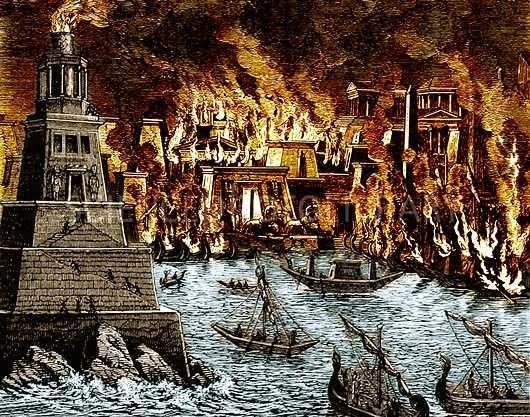
[
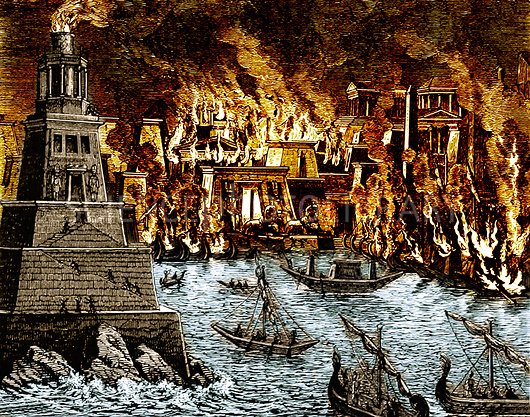 )
)
One version of the destruction of the Alexandria Library is depicted in the testimony of ancient Rome. According to some authors, the Library of Alexandria was inadvertently destroyed by Julius Caesar during the siege of the city in 48 BC. For example, Plutarch describes it this way:
"... when the enemy tried to cut his fleet (Julius Caesar), he was forced to drive out the danger of using fire, it spread from the shipyard and destroyed a large library."
(Plutarch, Life of Julius Caesar, 49.6)
But this version seems dubious, because the Museum (Mouseion), which is near the library, remains unharmed, as the geographer Strabo mentions about 30 years after the siege of Alexandria by Caesar. However, Strabo does not mention the Library of Alexandria itself, thus endorsing the assertion that Caesar was responsible for the fire. However, since the Library is part of the Museum mentioned by Starbon, it probably still exists. In addition, it is recommended that it is not a library burned, but a warehouse near the port where the manuscript is stored.
The second possible cause of death of the Great Library, probably Egyptian Christians in the 4th century. In 391, Emperor Theodosius issued a decree that officially prohibited the idolatry of the gods, resulting in the destruction of Serapeum (Temple of Serapis) in Alexandria. However, as you know, it's not the library of Alexandria, but its branch. In addition, no ancient source mentions the destruction of the time, of all types of libraries. As a result, there is no evidence of this version.
Finally, the probable cause of this crime is the Muslim Caliph Omar. According to the story, "John Grammatikus" (490-570 BC) Amr asked about how to deal with books from the Royal Library and Omar replied: "If this book is in harmony with the Quran, we do not need them, and if they oppose the Qur'an, destroy them . "In this story there are at least two inconsistencies. First, no mention of libraries, but only books. Secondly, it was written by a Syrian Christian writer and, perhaps, to create a negative image of the Muslim caliph Omar.
Unfortunately, archeology can not explain the mystery of the destruction of the Library of Alexandria. First of all, ancient papyrus, rarely found in excavations in the Mediterranean, may be due to unfavorable climatic conditions for the preservation of organic matter. Second, the remains of Alexandria's library itself were never found. This is due to the fact that modern Alexandria is built on the most ancient land in Ptolemies, and archaeologists have no chance to dig - because this must move almost the entire city.
Of course, more it is easy to blame one person or group of people for destroying what is considered the largest library in the ancient world. Maybe the library did not burn at all, but gradually lost its relevance. If his creation was required to display the wealth and power of Ptolemies, the decline could also be attributed to Egypt's economic decline and the coming of Arab conquests. But even if the library had gone through the first few centuries AD, the golden day was also recorded, because after the death of Cleopatra, the last of the Ptolemaic dynasty, the new center of the world had become Rome.
What to see in the modern Alexandria library
The architecture of Alexandrina's library is modern and bright, with a glass roof tilted to the sea, like a sundial. The main reading room covers 70,000 m² and can simultaneously accommodate 2000 readers. The complex offers 200 modern-equipped rooms for scientists and researchers. Book collections in the reading room are donated by countries around the world and cover a wide range of topics.
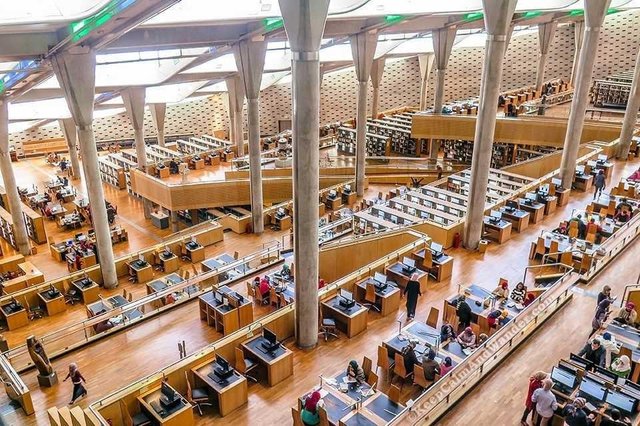
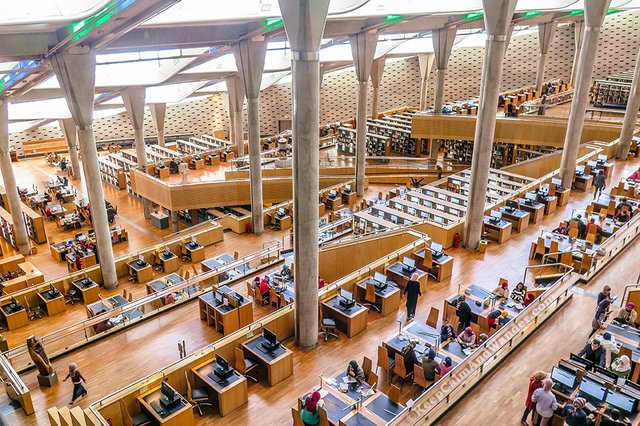 )
)
The "Manuscripts and Rare Books" gallery is located in the center of the library, occupying an area of 344 m2. It consists of 12 displays, donated by Italy in the framework of a cooperation agreement between the two countries, in addition to 20 displays in the Egyptian style, containing about 120 rare manuscripts and books. Two parts "kisva" (a decorative black cover of a brocade, embroidered with golden verses of the Quran) The Holy Ka'bah adorns the wall above the Islamic manuscript.
The Museum of Antiques in the Library of Alexandria presents a collection of artefacts found on the site of modern library construction. The exhibition consists of 1,100 copies and documents of various Egyptian civilizations, from the time of Pharaoh to the Islamic period, including the Greek, Roman and Christian periods, Coptic.
Other exhibits in the library include original carvings, lithographs, early photos and maps of Alexandria artists and XV - XIX century travelers, as well as permanent exhibitions dedicated to contemporary literary and cinematographic works.
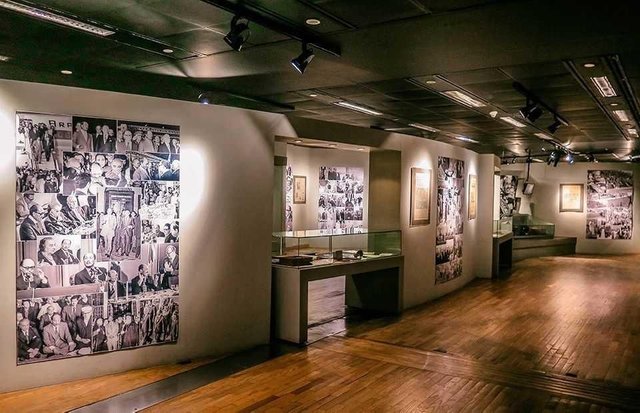
The Alexandrina Library also has a script recovery laboratory, a planetarium and a large conference room. In short - there is a lot to see!
